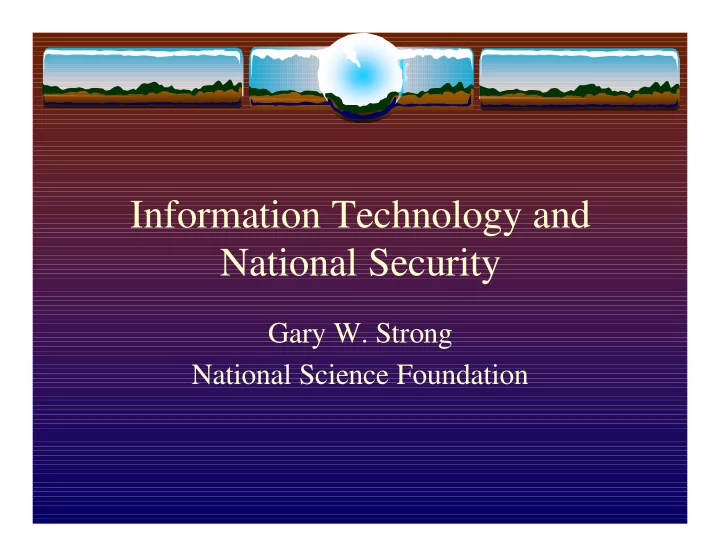

Information Technology and National Security Gary W. Strong National Science Foundation
NSF has a broad, cross- cutting research agenda that includes national security.
Interagency Cooperation on National Security Research • Culture of academia changed on Sept. 11 th – Researchers want to help • Need to know what the problems are • Workshops meet part of this need • NSF is engaged – There is a large base of peer-reviewed grantees • A workshop-based process has been invented • It was used once in KDD and will be used in other domains – Funded projects are already relevant • Determine who gets to participate • Challenges of relevance have been met by simple searches over NSF award database
The Big Challenge: Data Sharing/Data Mining • Relevant datasets are needed to drive research – Credit card fraud, telecommunications fraud, insurance fraud, and identity theft are good domain examples – Those data contain protected personal information and are private assets to companies • Artificial, simulated data is being proposed – Artificial data can be created in huge amounts (billions of transactions) – Scrubbing data is very expensive – Isn’t “dirty” enough • Data need to be coupled with evaluation, as in DARPA human language technology programs
Pattern base concept � The man-made fog of deliberate deception militates against pattern learning from data � Alternative strategy is to “think the unthinkable”. � Terrorists act like Darwinian species, seeking unexploited niches. � Need skill for breaking out of tacit knowledge � Similar to those of cultural anthropology, where World-views are not a given. � People can be trained to be skeptics, open to understanding other World-views. � Need baseline databases, such as for diseases, “normal behavior”, etc. � Need a pattern base � A new effort at both vulnerabilities estimation � Also pre-emptive strategies for countering them. � The patterns developed by analysts need to include those that will change a client’s mind. � There is a significant patternbase management problem. � There are patterns that can be discovered only if one takes time into account � Could be missed if information across collections is not integrated. � An example of such a type of pattern is cause-effect detection, when the channel is not yet discovered or still opaque. � NIMA and NSF are planning a workshop on time representation and research – please get in touch if you are interested. � West Nile Virus example suggests real pattern crosses stovepipes, for example, human and animal diseases. � It took months for these two lines to discover each other and resolve the true nature of the zoonosis. � Issues such as agro-terrorism, or infrastructure attacks may be even more complicated.
Data forensics � Need to find out how to frame questions, or create search patterns, that would help an analyst. � If the right questions aren’t posed, the analyst may head down a path with no conclusions. � Information literacy � assumes a knowledge of the kinds of queries one can pose on existing data � and how to decompose needs into such queries. � Spanning set of questions (sample that covers the set of all types) at different stages in analysis? � Could help focus the analyst as well as help the system identify where the analyst is going? � These could be derived from a meta-analysis study.
Real data, real problems driver suggests new infrastructure � Data needs � Extremely large size of one or more sets � Stream data � Unstructured data � Related, heterogeneous data sets � Multimodal data � “Dirty” data � Open to research community � Homogeneous in many characteristics to classified data/problems � Closer relationship between users and researchers � Better understanding of the problem � Possible faculty center on database, information retrieval intersection
Other Research Domains in Planning Stage • Pattern Recognition/Characterization of People, Places and Things • Spatio-Temporal Information Systems • Biological Warfare Defense • Sense-making/Augmented Cognition • Signal Processing • Global Change Detection • Measurements and Signatures Intelligence • Computational Social Systems • Management of Knowledge-Intensive Organizations
Summary • Agencies of Federal Government that didn’t talk much are collaborating once again at a very deep level • The Nation’s best science is being called up to serve and wants to serve • There are new processes being invented for addressing the needs • The solutions are likely to be a combination of technology and policy
More recommend